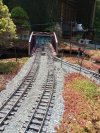JimmyB
Now retired - trains and fishing
As my railway expands along paving, and wanting to add ballast, as the rest of my railway is ballasted, thoughts turn to holding it in place, and I have seen all three of these (PVA vs SBR vs Easy Hold) used by different railway builders on here, so my questions are:
1) What are the differences between the products: i.e. pros and cons.
2) How is each of these used, e.g. neat, diluted, prayed etc.
Any help in aiding me to make my mind up would be appreciated.
I have visited a number of manufacturers' websites that produce both, and they provide very little insight, of it is over to you the end user and your experience - many thanks.
1) What are the differences between the products: i.e. pros and cons.
2) How is each of these used, e.g. neat, diluted, prayed etc.
Any help in aiding me to make my mind up would be appreciated.
I have visited a number of manufacturers' websites that produce both, and they provide very little insight, of it is over to you the end user and your experience - many thanks.







